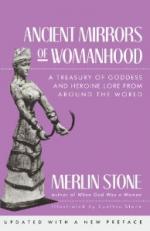|
This section contains 331 words (approx. 1 page at 400 words per page) |

|
Chapter 32, Ishtar Summary and Analysis
The most popular Goddess among the Semites of northern and central Mesopotamia is Ishtar. She is Queen of Heaven, descended from Venus. She is known to other people by different names: Mother of Deities, Lioness of the Igigi, Producer of Life, Ruler of the Heavens, and Lady of Battle and Victory. The Sumerian Goddess Inanna is thought to be one and the same with Ishtar. Many images of Ishtar also exist: as a horned holy cow in Egypt; carrying a bow and arrow; wearing a tiara upon her head; sitting upon her lion throne; and riding upon the back of a large bird.
Ancient carvings paying homage to the holy Ishtar can be found throughout the Near East. Prayers to Ishtar can also be found inscribed on stone and clay. Rituals for Ishtar involve the temple priestesses taking lovers...
(read more from the Chapter 32, Ishtar Summary)
|
This section contains 331 words (approx. 1 page at 400 words per page) |

|




